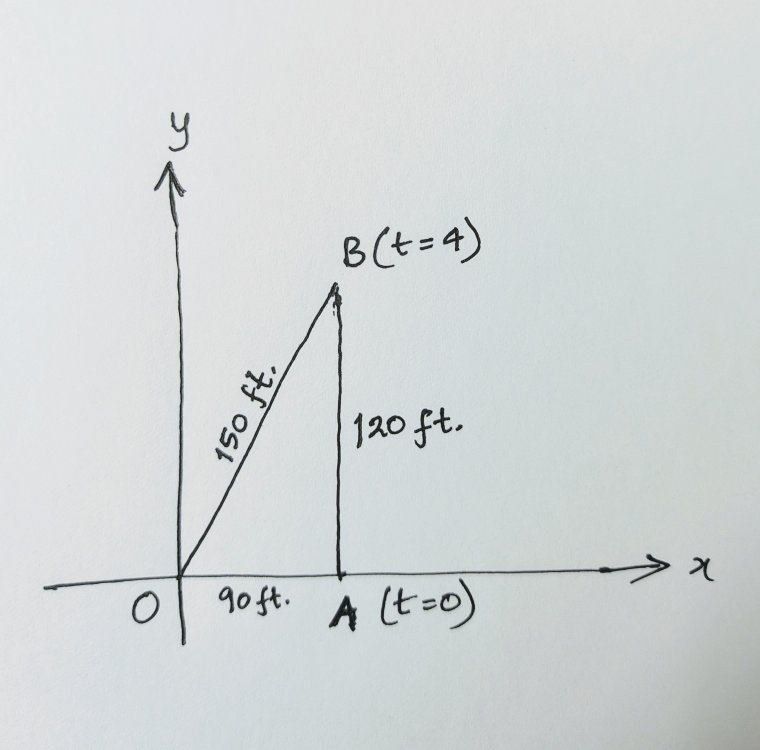-
Posts
38 -
Joined
-
Last visited
Content Type
Profiles
Forums
Events
Everything posted by murshid
-

Best resources for self-studying math from K-12?
murshid replied to Zephyr1779's topic in Mathematics
Have you tried Khan Academy? -
Can anyone suggest a good lecture series on Complex Analysis on YouTube? I have already searched on YouTube myself, and there are a few. But I wanted to know if any of you would recommend some particular lecture series which you consider to be good.
-
That's the part I did not understand. I did draw a diagram, but got confused by the language. So, I attached the diagram. O is the point where the lifeguard is. A is the point where the shark is at t = 0. So, OA = 90 feet. B is the point where the shark is 150 feet away from the lifeguard. So, OB = 150 feet. AB = sqrt (OB2 - OA2) = sqrt (1502 - 902) = 120 feet Since the shark is moving at a constant speed of 30 ft./s, it would reach B at t = 4 ; [ t = d/v =120/30 = 4 ] So, in 4 seconds, the shark went 150-90 = 60 feet further away from the lifeguard. The speed at which the shark is moving away from the lifeguard at B = 60/4 = 15 ft./s Is that it?
-
Here is the problem: Now, if the speed is constant, then shouldn't the answer be 30 feet per second no matter where the shark is?
-
[math]\frac{\pi^{2}}{6}[/math] (test)
-
\frac{\pi^{2}}{6} (test) What am I doing wrong? Why isn't it working? .
-
That sounds a bit weird.
-
I just wanted to learn some hyperbolic geometry by myself. And I found this YouTube channel which has many lectures on many different math topics: https://www.youtube.com/user/njwildberger Has anyone tried his lectures before? Is he any good?
-
1. How common is schizophrenia among children (e.g. 10-15 year old or even younger)? 2. Does schizophrenia has any cure? Is there any instance of a person being fully cured of it? Thanks in advance!
-
I was also not sure what the article (http://news.discovery.com/space/do-we-live-in-a-spinning-universe-110708.html) meant by "the universe". Perhaps they meant the observable universe, although I can't be sure. .
-
. What do you guys think of this news: "Is the Universe Spinning?" What is the universe spinning with respect to? Has there been any further developments regarding the discovery? .
-
Thanks a lot for your help, but I have come here to tell you guys that I've just figured out my mistake. I got the areas of the rectangles wrong. The sum of the areas would be, [math]A_r = (a - ar)a^n + (ar - ar^2)(ar)^n + (ar^2 - ar^3)(ar^2)^n + \cdots[/math] [math]A_r = a^{n+1}(1 - r) \left(1 + r^{n+1} + r^{2(n+1)} + \cdots \right)[/math] [math]A_r = \frac{a^{n+1}(1 - r)}{1 - r^{n+1}}[/math] DrRocket, yes, it is a crude approximation, which is why Fermat reasoned that the width of each rectangle must be made small. And for this, r must be close to 1. [math]A_r = \frac{a^{n+1}(1 - r)}{1 - r^{n+1}}[/math] [math]A_r = \frac{a^{n+1}(1 - r)}{(1 - r)(1 + r + r^2 + \cdots + r^n)}[/math] [math]A_r = \frac{a^{n+1}}{1 + r + r^2 + \cdots + r^n}[/math] As we let [imath]r \rightarrow 1[/imath], each term is the denominator tends to 1, resulting in, [math]A = \frac{a^{n+1}}{n + 1}[/math] And that is the integration formula [math]\int_{0}^{a} x^n dx = \frac{a^{n+1}}{n + 1}[/math] .
-
I am currently reading the book "e: The Story of a Number" by Eli Maor. And I got stuck at something. In chapter 7 of the book, the author described the method Fermat used to calculate areas under curves of the form [imath]y = x^n[/imath], where n is a positive integer. I am quoting the relevant bit here (sorry, I can't show the figure, but from the description, you can easily receate it): Now I can't get to the final formula. The areas of each rectangle I found are [imath]a^{n+1}, (ar)^{n+1}, (ar^{2})^{n+1},[/imath] and so on. Their sum, [math]A_{r} = a^{n+1} + (ar)^{n+1} + (ar^{2})^{n+1} + \cdots[/math] [math]= a^{n+1}\left(1 + r^{n+1} + r^{2(n+1)} + \cdots \right)[/math] [math]= \frac{a^{n+1}}{1 - r^{n+1}}[/math] Where am I getting wrong? .
-
Try this: [math]\frac{2\times\pi\times8.8\times10^8 m}{8834s} = 625900 m/s[/math] [math]\frac{2\times\pi\times8.8\times10^8 m}{8834s} = 625900 m/s[/math] or this: [math]\frac{2\times\pi\times8.8\times10^8 m}{8834s} = 625900 m{s}^{-1}[/math] [math]\frac{2\times\pi\times8.8\times10^8 m}{8834s} = 625900 m{s}^{-1}[/math]
-

Need help from someone who knows about databases & banks
murshid replied to murshid's topic in Homework Help
I work in the Human Resources division of a bank and my boss gave me these questions. I have no idea why he needs to know that or why he asked me. Anyway, thanks a lot for your help, markearthling! It would have been better if you could have been slightly more specific with your answers, but I really appreciate your help. If you have any more ideas, please do share it here. . -
. I really need help in answering the two questions stated at the end of the quote below: I'll be really grateful to anyone who can help. Thanks in advance. Edit: I'm not sure whether I put this in the right sub-forum. If I didn't, I hope the mods will move it to the appropriate section. .
-
A set is defined as: "A set is a finite or infinite collection of objects in which order has no significance, and multiplicity is generally also ignored (unlike a list or multiset)." (link) This is my question: can it be a collection of real objects or does it have to be a collection of abstract or conceptual objects only?
-
. Is this possible? Or is it photoshopped?
-
:lol: .
-
Thanks!
-
So it seems. .
-
Can anyone tell me how accurate/inaccurate this is: http://video.google.com/videoplay?docid=-3309910462407994295#


